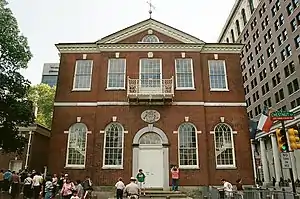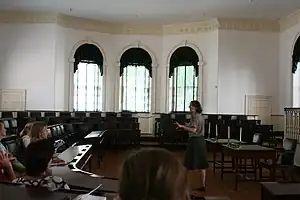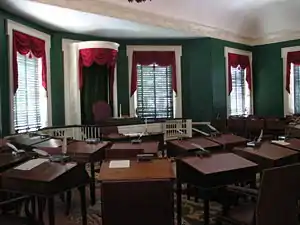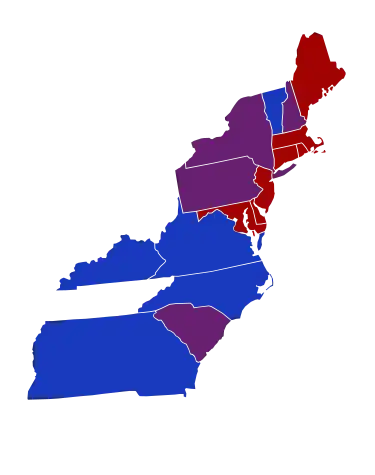| 3rd United States Congress | |
|---|---|
2nd ← → 4th | |
 Congress Hall (2007) | |
March 4, 1793 – March 3, 1795 | |
| Members | 30 senators 105 representatives 1 non-voting delegates |
| Senate majority | Pro-Administration |
| Senate President | John Adams (P) |
| House majority | Anti-Administration |
| House Speaker | Frederick Muhlenberg (A) |
| Sessions | |
| Special: March 4, 1793 – March 4, 1793 1st: December 2, 1793 – June 9, 1794 2nd: November 3, 1794 – March 3, 1795 | |
The 3rd United States Congress was a meeting of the legislative branch of the United States federal government, consisting of the United States Senate and the United States House of Representatives. It met at Congress Hall in Philadelphia, Pennsylvania from March 4, 1793, to March 4, 1795, during the fifth and sixth years of George Washington's presidency.
The apportionment of seats in the House of Representatives was governed by the Apportionment Act of 1792 and based on the 1790 census. The Senate had a Pro-Administration majority, and the House had an Anti-Administration majority.

Major events
- March 4, 1793: President George Washington begins his second term.
- April 22, 1793: George Washington signed the Neutrality Proclamation
- February 11, 1794: Wishing to avoid charges of being a Star Chamber, the Senate holds its first public session, resolving "That the Senate doors be opened".[1][2]
- March 14, 1794: Eli Whitney was granted a patent for the cotton gin
- March 27, 1794: The federal government authorized the construction of the original six frigates of the United States Navy
- August 7, 1794: Whiskey Rebellion began: Farmers in the Monongahela Valley of Pennsylvania rebelled against the federal tax on liquor and distilled drinks.
- August 20, 1794: Battle of Fallen Timbers — American troops under General Anthony Wayne forced a confederacy of Shawnee, Mingo, Delaware, Wyandot, Miami, Ottawa, Chippewa and Pottawatomie warriors into a disorganized retreat.

Major legislation
- January 13, 1794: Flag Act of 1794, Sess. 1, ch. 1, 1 Stat. 341
- March 22, 1794: Slave Trade Act of 1794, Sess. 1, ch. 11, 1 Stat. 347
- March 27, 1794: Naval Act of 1794, Sess. 1, ch. 12, 1 Stat. 350
- January 29, 1795: Naturalization Act of 1795, Sess. 2, ch. 20, 1 Stat. 414
Constitutional amendments
- March 4, 1794: Approved an amendment to the United States Constitution clarifying judicial power over foreign nationals, and limiting the ability of citizens to sue states in federal courts and under federal law, and submitted it to the state legislatures for ratification 1 Stat. 402.
- February 7, 1795: The 11th Amendment to the United States Constitution was ratified by the requisite number of states (then 12) to become part of the Constitution.
Treaties
- November 19, 1794: The United States and the Kingdom of Great Britain signed the Jay Treaty, which attempted to clear up some of the lingering problems left over from the American Revolutionary War
Faction summary
There were no political parties in this Congress. Members are informally grouped into factions of similar interest, based on an analysis of their voting record.[3]
Details on changes are shown below in the "Changes in membership" section.
Senate
| Faction (shading shows control) |
Total | Vacant | ||
|---|---|---|---|---|
| Anti- Administration (A) |
Pro- Administration (P) | |||
| End of previous congress | 13 | 17 | 30 | 0 |
| Begin | 14 | 16 | 30 | 0 |
| End | 13 | 17 | ||
| Final voting share | 43.3% | 56.7% | ||
| Beginning of next congress | 10[lower-alpha 1] | 20[lower-alpha 2] | 30 | 2 |
House of Representatives

| Faction (shading shows control) |
Total | Vacant | ||
|---|---|---|---|---|
| Anti- Administration (A) |
Pro- Administration (P) | |||
| End of previous congress | 32 | 40 | 72 | 1 |
| Begin | 55 | 50 | 105 | 0 |
| End | 53 | 103 | 2 | |
| Final voting share | 51.5% | 48.5% | ||
| Non-voting members | 1 | 0 | 1 | 0 |
| Beginning of next congress | 58[lower-alpha 3] | 47[lower-alpha 4] | 105 | 0 |
Leadership
Senate
.jpg.webp)
- President: John Adams (P)
- President pro tempore: John Langdon (P), until December 2, 1793
- Ralph Izard (P), May 31, 1794 – November 9, 1794
- Henry Tazewell (P), from February 20, 1795
House of Representatives
Members
This list is arranged by chamber, then by state. Senators are listed by class, and representatives are listed by district.
Senate
Senators were elected by the state legislatures every two years, with one-third beginning new six-year terms with each Congress. Preceding the names in the list below are Senate class numbers, which indicate the cycle of their election.
Connecticut
Delaware
Georgia
Kentucky
Maryland
Massachusetts
New Hampshire
New Jersey
|
New York
North Carolina
Pennsylvania
Rhode Island
South Carolina
Vermont
Virginia
|
 Senators' party membership by state at the opening of the 3rd Congress in March 1793.
2 Anti-Administration
1 Anti-Administration and 1 Pro-Administration
2 Pro-Administration |
 John Langdon (until December 2, 1793)  Ralph Izard (May 31, 1794 – November 9, 1794) .jpg.webp) Henry Tazewell (from February 20, 1795)
|
House of Representatives
The names of members of the House of Representatives are preceded by their district numbers.
Changes in membership
The count below reflects changes from the beginning of the first session of this Congress
United States Senate
There were 1 death, 3 resigns, 1 late election, and 1 contested election.
| State (class) |
Vacated by | Reason for change | Successor | Date of successor's formal installation[lower-alpha 5] |
|---|---|---|---|---|
| Connecticut (3) |
Roger Sherman (P) | Died July 23, 1793. | Stephen M. Mitchell (P) | Elected December 2, 1793 |
| Delaware (1) |
George Read (P) | Resigned on September 18, 1793. Kensey Johns was appointed on March 19, 1794, but not permitted to qualify. | Henry Latimer (P) | Appointed February 7, 1795 |
| Pennsylvania (1) |
Albert Gallatin (A) | Credentials were contested and the seat was declared vacant February 28, 1794. | James Ross (P) | Elected April 24, 1794 |
| Virginia (1) |
James Monroe (A) | Resigned May 11, 1794, to become United States Minister to France. | Stevens T. Mason (A) | Elected November 18, 1794 |
| Virginia (2) |
John Taylor (A) | Resigned May 11, 1794. | Henry Tazewell (A) | Elected November 18, 1794 |
House of Representatives
There were 2 deaths, 3 resignations, and 1 contested election.
| District | Vacated by | Reason for change | Successor | Date of successor's formal installation[lower-alpha 5] |
|---|---|---|---|---|
| Delaware at-large | John Patten (A) | Contested election; served until February 14, 1794. | Henry Latimer (P) | Seated February 14, 1794 |
| Territory South of the River Ohio | Vacant | Delegate seat established. | James White Non-voting delegate | Elected September 3, 1794 |
| Maryland 2nd | John Francis Mercer (A) | Resigned April 13, 1794. | Gabriel Duvall (A) | Seated November 11, 1794 |
| New York 10th | Silas Talbot (P) | Accepted appointment to the U.S. Navy June 5, 1794. | Vacant | Not filled in this Congress |
| New Jersey at-large | Abraham Clark (P) | Died September 15, 1794. | Aaron Kitchell (P) | Seated January 29, 1795 |
| South Carolina 5th | Alexander Gillon (A) | Died October 6, 1794. | Robert Goodloe Harper (P) | Seated February 9, 1795 |
| Maryland 3rd | Uriah Forrest (P) | Resigned November 8, 1794. | Benjamin Edwards (P) | Seated January 2, 1795 |
| Delaware at-large | Henry Latimer (P) | Resigned February 7, 1795, having been elected U.S. Senator. | Vacant | Not filled in this Congress |
Committees
Lists of committees and their party leaders.
Senate
House of Representatives
- Claims (Chairman: Uriah Tracy)
- Elections (Chairman: William Loughton Smith then Jonathan Dayton)
- Rules (Select)
- Ways and Means (Chairman: William Loughton Smith)
- Whole
Joint committees
- Enrolled Bills (Chairman: John Rutherfurd)
Employees
Senate
House of Representatives
- Chaplain: Ashbel Green (Presbyterian)
- Clerk: John J. Beckley
- Doorkeeper: Gifford Dalley
- Reading Clerks: [data missing]
- Sergeant at Arms: Joseph Wheaton
See also
- 1792 United States elections (elections leading to this Congress)
- 1794 United States elections (elections during this Congress, leading to the next Congress)
Notes
- ↑ Democratic-Republican
- ↑ Federalist
- ↑ Democratic-Republican
- ↑ Federalist
- 1 2 When seated or oath administered, not necessarily when service began.
References
- ↑ "Precedents Relating to the Privileges of the Senate of the United States". U.S. Government Printing Office. January 1, 1893 – via Google Books.
- ↑ "U.S. Senate: 1787: Senate Opens Its Doors -- December 9, 1795". United States Senate.
- ↑ Martis, Kenneth C. The Historical Atlas of Political Parties in the United States Congress.
- Martis, Kenneth C. (1989). The Historical Atlas of Political Parties in the United States Congress. New York: Macmillan Publishing Company.
- Martis, Kenneth C. (1982). The Historical Atlas of United States Congressional Districts. New York: Macmillan Publishing Company.
